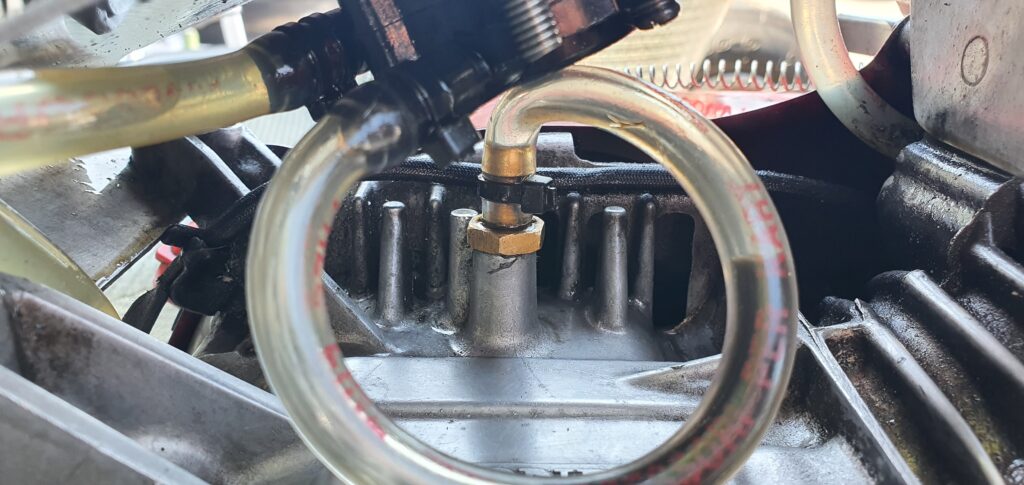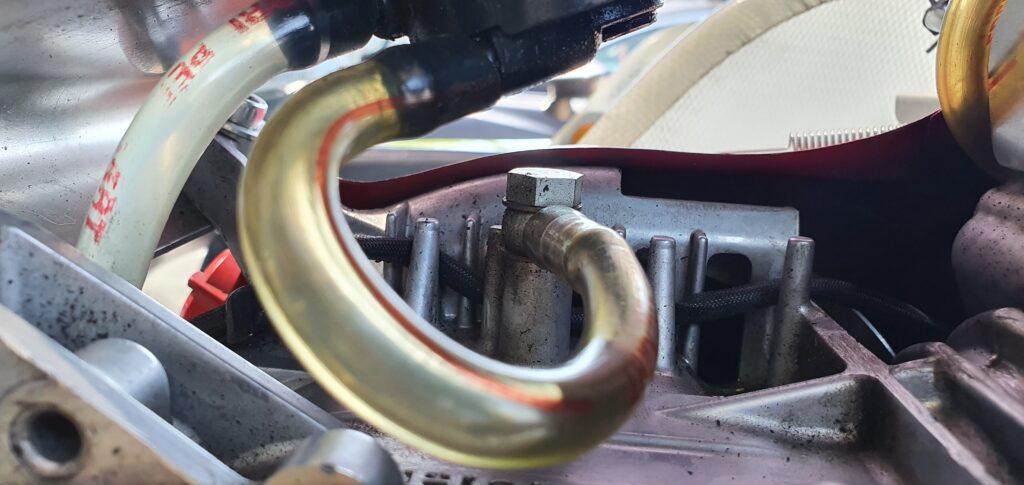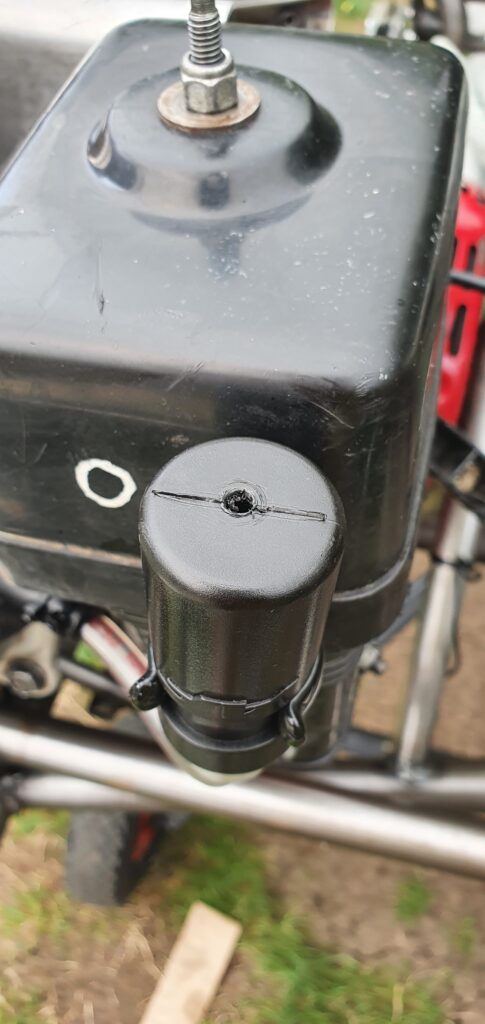We got the kart ready for the second test session as seen in Preparing for Test Session, all was good and we were excited to go. This test session would be a huge 6 hours long. Alright the time on track would be 10 or 15 minutes at a time depending on the classes that were attending but still, 6 hours is a lot of bum in seat time for sure! We had a nice early start – up at half 6 to be on the road before 715 giving an hour to setup and sign on before being on track at 9. Needless to say, we were both excited. Eldest had been studying the lines and track on YouTube etc, we had made changes to the kart. This was going to be a good day.
Except it wasn’t. I ordered a Gazebo to provide us with some cover from the sun, it was due to be (and actually was) a very hot one. So, when it didn’t arrive on Saturday a late night dash to pick one up from the supermarket occured. This was a small Gazebo and didn’t have room to work on the kart in but what it did do was provide some shade from the baking sun.
9am rolls round, we have checked the kart and set everything up so out on track it is. First session goes well, eldest looks faster. Watching him, he’s driving better, his lines look good from what I see on the pit wall. When no sooner as it starts, the session comes to the end. In comes the eldest and we hit the data button and sure enough 48 second lap time! He is actually faster! Result, but then disaster. I spot that the engine is covered in oil. Like it’s spewed out everywhere.
Get the kart back to the pits, start investigating, I can see it’s coming from the crankcase/pulse pump feed. Oh great, the new clips aren’t securing it fully. Off with the clips and on with cable ties. Start it up and it’s still pushing oil out. This is not good. I switch out the fuel pump for the one I purchased as part of the refurb work, start it up, rev it and no joy. It’s still pushing oil out, now it’s obvious it’s coming out of the fuel pump. This is where my knowledge comes up short. Why is oil spewing out?
On site at Rye House is Tornado Engines. I wheeled the kart around to them, by this point we have already missed a session. Unfortunately for us, the only person working that day was a senior kart specialist. They spoke to some of the others and the immediate diagnosis was that the breather connector was wrong.

In the above picture you can see that the connector from the crank case is straight through. The diagnosis was essentially that the oil was being flung straight up as part of the engine revolution then unrestricted going through the connector, into the pipe where it was then blown through the fuel pump. Newer karts tend to run a banjo bolt instead which prevents (doesn’t stop it entirely) this from happening. Because the hole through the bolt and then round the banjo are much smaller, it allows airflow to power the pump but it’s much more difficult for the oil to get through. A banjo bolt setup is shown below, where you can see a small amount of oil in the pipe.

The general advice was it’s OK to use, but just keep it topped up with oil. I think this may have been part of our downfall for the day. How much oil should one of these engines have? I can see some on the dipstick but no min/max level indicators. I suspect that at this point I put too much oil in, which then meant that more and more was being forced out. We got the kart ready and just about made the last session before lunch, when there was an hour break to allow a hire kart race to happen.
Cleaning the engine and everything was a faff but we did our best, topping it up with oil as we go. However, all afternoon we had issues with the engine just cutting out. I can see we get air in our fuel lines which I do not believe is a good thing. I was able to often clear it by blowing down the expansion tube, essentially pressurising the system but this wasn’t a good fix. More often than not the kart would just cut out half way round. I replaced a few clips with cable ties, and on one instance managed to disconnect the throttle linkage so it just sat at full throttle which meant another session was missed whilst I fixed this.
Try as I might, I was unable to resolve the issue with oil spewing out of the pulse pump, I feel that we were battling this oil issue which was impacting the engine performance, especially with the fuel pump being driven by vacuum/pressure from the crank case. We called it a day before the last session and decided to pack up, go home and I would try and get the breather situation sorted.
Things went from bad to worse, with us opening/closing the car all day the battery had gone flat. I needed a jump start in order to get going. Fortunately, a very helpful family were able to assist and get the car running to get us home. It’s something that happens quite regular on the Range Rover, because of all the electrics on there. I normally have a spare battery & jump leads hanging around just in case this thing happens. Maybe with a trailer this won’t be an issue?
To top off the day, when we got home, I found a load of oil in the back of the car. The cap on the oil bottle had cracked and split allowing oil to seep everywhere. Needless to say this was like a perfect end to the day.
It wasn’t all bad
Despite the issues above, it wasn’t all bad. The “improvements” had made a difference as we had found the next weak link in the kart. The fact we had found an issue on the kart at a test session and not on an event was a good thing as well, it would have been horrible to be at an IKR event and not get any running time. Remember how I mentioned that the eldest looked faster in the first session, well, he most definitely was, putting in a few 48 second laps with his fastest being 48.3 I think it was.
The other big improvement that we saw, when he actually got some running time, was with consistency. The lap times were fluctuating within 2 seconds which was a smaller fluctuation than last time. Looking at the Alfano data, the lines he used were also much more consistent with the line being shown in very similar places and not all over the show. The data definitely backed up what I was watching out on track.
Overall, my eldest can definitely hold his head high with the limited performance shown on Sunday. His driving was so much better to watch and much fewer mistakes where he got distracted looking for daisies (we won’t mention the pit lane entry!). Definitely a big step up for him.
As well as the learning on track, we did manage to speak to one of the other father/son pairings that were out testing. We noticed them on the first test session as one of the quick kids. They compete in the IKR series held at Rye House. Interestingly, their son had come through the K1 Stars series which is the Bambino class starting from aged 5. As part of this they were able to give some clues and tips about one of the other drivers in the Rookie Cup, who had also come through the K1 Stars scholarship. This was definitely very useful so thank you.
Post Test Checks and Fixes
After the test session, we got the kart home and unloaded it. The engine came off and was thrown in the boot of the car. I spoke to Tornado Engines that evening and arranged to take it over to Tornado Engines. They took a look at it, gave it a quick clean and replaced the connector with a banjo bolt setup. Luckily we didn’t need to drill and tap the crank case for this to be installed. They also replaced the valve cover gasket as I knew that was weeping and lastly did an oil change. It’s useful to know that we need to use 400ml of oil as well, not knowing this was why I didn’t change the oil myself.
With the banjo bolt installed, I started the engine and still found too much oil going in to the pipework and pulse pump. I decided to post on the Karting UK Facebook group, which proved very useful. I was advised to check the breather because as pressure builds in the head, if it’s not released, it will pressurise the crank case and then this causes the oil to spew out through the available breathing hole. This caused me to go back to the regs and the breather bottle. The
Rocker cover
Honda GX 160 Technical Regulations v16, section 11
Rocker cover must be standard and unmodified, although it may be painted or chromed. Its valve must be present and in working order. The breather pipe must be in position and intact, of suitable length, it must be securely fixed in both the rocker cover and the outlet of the airbox, and have no perforations or leakage points. For Cadet only, this pipe must be interrupted and fed into a breather bottle as shown, which must have a 4mm hole in its upper surface
The last sentence in that paragraph is key to the issue we suffered. Despite buying a breather kit for making the kart compliant, the catch bottle that gets installed doesn’t actually allow the engine to breathe! Needless to say, I have drilled a 4mm hole in the top (bottom of the bottle) and needless to say the engine now breathes and although some oil does make its way in to the pipe, this is to be expected and isn’t an issue unless it’s excessive.

Next up, we will look to try and do another days test and get in a cadet club session.
